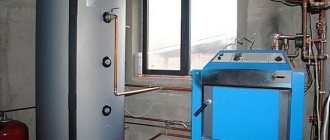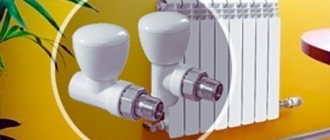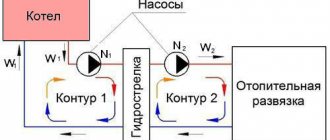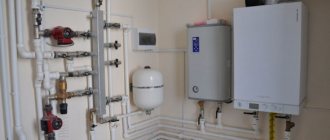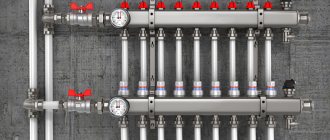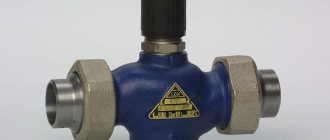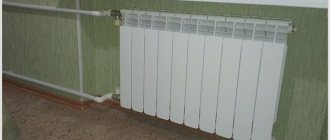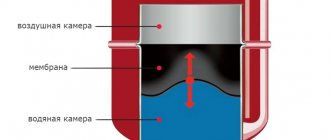Professional installation, high-quality materials and a well-thought-out design of heating communications do not guarantee heat in the house if the heating system does not have a small part for bleeding air. The problem of airy cold radiators is familiar to both residents of multi-storey buildings and the owners of a private mansion. To avoid this, an air valve is installed for the heating system.
Types of air vents and their installation locations
Air vents are manual and automatic. Manual air vents or Mayevsky taps are small in size. They are usually installed on the end of the heating radiator. The Mayevsky tap is adjusted using a wrench, a screwdriver, or even manually. Since the faucet is small, its performance is low, so it is used only for local elimination of air locks in the heating system.
Air vents for the heating system are of two types: manual (Mayevsky tap) and automatic (work without human intervention).
The second type of air vents - automatic - operate without human intervention. They are installed both vertically and horizontally. They have high performance, but are quite sensitive to contaminants in water, so they are installed together with filters on both supply and return pipelines.
Automatic air vents are installed in closed heating systems along the pipeline line at different points. Then air is released from each group of devices separately. A multi-stage deaeration system is considered the most effective. With proper laying and proper installation of pipes (at the required slope), removing air through air vents will be simple and hassle-free. Removing air from heating pipes is associated with an increase in coolant flow, as well as an increase in pressure in them. A drop in water pressure indicates a violation of the tightness of the system, and temperature changes indicate the presence of air in the heating radiators.
Components of equipment
It is worth taking a closer look at the parts of the system that were mentioned above.
Disassembled crane
The operating principle is described in the air release instructions. The design of the Mayevsky crane is easier to study using this drawing. Such a miniature product is installed instead of a plug in the upper part of the collector comb. There is a carving in the central part. A screw is screwed in there, pressing the plastic seal.
Why is an air lock in the radiator dangerous?
If there is air in the battery, nothing good will come from it.
Excess air is an obstacle to the normal functioning of the system. It can also cause corrosion on the walls of the radiator. If a circulation pump is installed in the circuit. an air lock can also disrupt its operation. When the system is functioning correctly, the plain bearings on the shaft of the pump unit are constantly in the water. And if there is air, a “dry friction” effect occurs, which negatively affects the sliding rings and can damage the shaft
Therefore, it is important to know how to remove air from your home heating system. Timely measures will help prevent damage to the heating network
Video
In any case, the heating system should be inspected regularly. To remove air, you must follow the instructions exactly. If an engineering structure is highly complex, and independent actions cause difficulties, you need to seek help from specialized specialists. In addition to removing air, they can be entrusted with adjusting the manifold comb.
He has built thousands of multi-storey buildings and knows almost everything about thermal insulation and sound insulation. I am always happy to answer your questions on these topics.
Source
Bleeding air through the plug
If there are no taps on the heating devices, a problem such as an air lock in the home heating system becomes much more complicated. You will need to unscrew one of the plugs.
For these purposes, you should prepare a large adjustable wrench. You need to place a container under the plug. Next, the key grabs the plug and turns it very carefully. It is unacceptable to completely unscrew the plug, since there may be high pressure in the heating system, the coolant will go straight into the room with high pressure, and it will be problematic to cope with the current situation
That is why the plug should be turned with extreme caution. It is advisable to first turn off all available equipment in the room and close window and door openings tightly. While turning the plug, you need to listen
If a slight hissing noise appears, do not turn the plug any further. At this moment you need to stop and put the key aside. Now you should wait until the excess air from the heating device gradually but completely leaves the system. It is very simple to determine that the plug in the heating system has come out - liquid will begin to leak from under the plug. Then, using a large adjustable wrench, you need to smoothly and carefully return the plug to its original position.
Tips and tricks
As you know, the more complex the equipment, the higher its cost, while such a device is less reliable. Therefore, in order for the hydrofloor to work properly, you need to buy and install high-quality components.
Today there is a huge range of kits for installing water floors on the market. When choosing, you should carefully read their characteristics and features.
You can use a mechanically driven device, which is reasonably priced. In addition, the operation has been proven by many years of practice, so it rarely breaks down. Devices with a sulfur drive are more expensive, and there are more elements that can fail in this design.
When choosing a device for bleeding air, experts recommend paying attention to Mayevsky taps - they are reliable, durable and do not need adjustment.
Automatic devices have a more complex design and are more expensive. In addition, they become unusable when dirty.
As you can see, air locks lead to malfunctions, but this problem is easy to solve. The main thing is to bleed the air from the pipeline in time, and this must be done correctly and regularly.
Types of air vents
Valves for removing air locks are automatic and manual. The second type of air vents includes Mayevsky taps. They are used not only to remove air, but also to start it up in order to drain the coolant from the system.
Mayevsky crane
This device is made of brass and has a simple but reliable design. The main parts of the Mayevsky crane are the body and the screw. All valve parts are located as closely as possible to each other, so that the coolant cannot escape outside. Open the tap using a special key, screwdriver or hand.
Before removing air from the heating system, it is necessary to prepare a container for the coolant and tools. Step-by-step instructions for removing air pockets using a Mayevsky crane:
- If the heating system operates using a circulation pump, it should be turned off while the air is being vented.
- Using a wrench, screwdriver or hand, turn the tap 1 turn counterclockwise. You will immediately hear the hiss of air escaping from the radiator.
- As soon as the coolant begins to flow out, it means that the air lock has been removed, the Mayevsky valve is closed back.
Automatic air vent
Automatic air vent VALTEC VT.502
This device independently removes air from the heating system. Installs either vertically or horizontally. Consists of a brass body, float, release valve and articulated arm. To prevent coolant from leaking through it, the air vent is equipped with a protective cap.
Note! Automatic devices are sensitive to impurities contained in water. For long-term operation, cleaning filters are additionally installed in the heating system.
The operating principle is as follows: if there is no air in the chamber, then the outlet valve is closed. As it moves in, the float lowers. Once the chamber is completely filled, the exhaust valve opens and the air is discharged outside. The float then closes the outlet valve again.
Air separator
This device consists of a metal body, an air vent, a drain valve and a tube with a mesh. Unlike conventional air vents, the separator itself removes air from the water. As the coolant passes through the mesh, it swirls, causing air bubbles to form. As a result, they rise to the top, and the gases are removed through the air vent. In addition to air, the separator separates sand, rust and other impurities. Remove sludge through a drain valve located outside at the bottom of the housing.
Design features
It is necessary to take into account in advance the details that distinguish certain equipment. So, in some situations, a built-in boiler pump is used to circulate coolant throughout all circuits. For a large facility, its performance may not be enough, so you will need to install a separate power unit.
When using radiator heating, routes are created with a minimum number of turns, without sharp corners. By adding tilts towards the boiler, natural circulation can be ensured under the influence of gravity.
In heated floors, long pipelines with a large number of bends are installed
It is more difficult to pump water through such a system. Only coercive methods are used here. If there are errors in the calculations, the power of a separate pump will not be enough for distant circuits. In this case, their poor heating cannot be eliminated by removing air plugs. The system will need to be modernized.
The comb regulators must first be correctly adjusted. In addition to mechanical flow meters, valves with electric drives are installed. Such devices change the coolant supply rate taking into account the readings of temperature sensors.
What are air vents and what are they for?
Many owners of radiator systems have encountered a situation where, with hot pipes, some parts of the radiator do not heat well or are generally cold; similar problems arise with insulation with water floors. The main reason for this phenomenon is the presence of air in the pipes, which rises and impedes the movement of the coolant.
If in an open circuit air bubbles are sent to an unclosed expansion tank located on high floors of a building or attic, and bleeding is not so important, then in a closed system an air bleeder for the heating system is vital on all circuits and individual heat exchange devices.
When plugs interfere with the operation of the system, manual or automatic heating drain valves are used to remove accumulated air. One of the simplest devices is a regular valve installed at the top point of heating radiators. To bleed air from the batteries, open the valve and wait for the moment when the stream stops flowing jerkily along with the air - in radiators without air, the water flow will be uniform.
In individual heating lines of private houses, instead of ordinary valves, special locks are installed on the radiators, which function automatically or are manually adjusted. With their help, they remove not only air from devices in which gas formation occurs, but also, when necessary, oxygen from water, which causes accelerated corrosion of metal fittings.
Rice. 2 Air vent for venting air from the heating system - design
Cast iron batteries
The Mayevsky crane simplifies the work, but not all batteries have such a convenient device. For example, on cast iron versions you can often find a regular plug screwed onto tow and coated with paint. Removing it is problematic. Of course, you can visit the neighbors below or above, who have a Mayevsky tap on the radiator - this way you can gain access to the coolant. But this is not always possible.
We'll have to resort to the "old-fashioned" method. You will need a basin, a bucket and a lot of unnecessary rags. You don’t even have to try to unscrew the plug with your bare hands; you need to take an adjustable wrench. A paint thinner will also come in handy; the plug must have dried firmly over a long period of time. Then follow the instructions:
- Apply solvent to the plug and wait twenty minutes.
- Run along the thread with an adjustable wrench until the plug gives way. You should hear the sound of air escaping.
- When the sound dies down, you need to wrap a new layer of “fumka” around the plug and insert it in its original place. If necessary, touch up the joint.
In order not to worry about heating the room in winter, you just need to promptly remove air pockets that interfere with the normal movement of the coolant. The result will be a warm, cozy atmosphere in the house even in the most severe frosts.
Correct option
To carry out a successful operation, an adjustable wrench is a must, as well as a basin and rags. You will need to purchase tow, FUM tape or sealant. It is imperative to shut off the coolant supply. The following steps are performed sequentially:
- First, remove the tow, but first place a container under the radiator. If you can’t get to the tow right away, then remove (dissolve) the paint.
- Carefully, slowly unscrew the plug. Any sudden movements or great efforts are avoided, because there is always a risk of breaking the thread.
- If the element does not lend itself, then use a solvent or WD-40, a rust converter. The product is poured into the problem joint.
- Then they pause: wait 5-10 minutes. Then they repeat the steps, also carefully. The operation is stopped when an extraneous sound appears.
- After unscrewing the plug, the air masses begin to gradually bleed off, this process is always accompanied by hissing.
- At the end of this stage, approximately 3-5 liters of water are drained. These actions will minimize the chance of encountering a traffic jam again.
Then the plug is screwed tightly again, having previously wound a new portion of tow. It can be replaced with more modern products - FUM tape. However, they believe that the best option is a combination of these materials. But the shrinking tape has a competitor: they often prefer to coat tow with sealant rather than wrap it with fumigation. For example, UNIPAK sealing paste.
After these manipulations, open the coolant supply valve. Since this method is very complicated, if you lack the skills, it is better to call a specialist, since a leak can be very expensive for the owners. Any master plumber, on the contrary, is well aware of how to bleed air from a battery.
Unsafe express method
If the radiator has been standing since “antediluvian” times, then it is quite possible that the owner will not be able to cope with unscrewing the plug on his own. In this case, some recommend an original method - drilling a hole in it.
To do this you will need a drill, a screwdriver and a metal drill (maximum diameter 4 mm). You also need to find a self-tapping screw; its diameter should be 1.5-2 mm larger than the hole. You will need a rubber gasket under it. To ensure the reliability of the “hot spot”, it is recommended to use a sealant.
The work itself is simple, but must be done quickly.
- First, drill a hole, then carefully and slowly pull out the drill.
- After this, the air will come out and water will begin to flow, quickly screw in the self-tapping screw with the gasket on it.
They say that pre-coating this structure with sealant guarantees almost one hundred percent reliability of the system. If the owner has a desire to test this “maximum”, then he is a person who is not afraid of possible consequences.
Causes and consequences of air locks in a closed heating system with forced circulation
The reasons are the same as for an open system, plus:
- A loose circulation pump impeller can “grab” air during operation;
- If hot water is supplied to the expansion tank from above, then air can enter the system through cracks or breaks in the tank membrane.
An air lock in a closed circuit will lead to increased pressure in the system and activation of the safety valve. The valve will bleed water over and over again until the boiler burns out or the heating pipes rupture. Therefore, security requirements for closed systems are much stricter. In particular, for air release, the closed circuit is equipped not only with manual Mayevsky valves, but also with automatic air vents. One of these automatic valves is included in the safety group. The group is placed on the water supply, immediately after the boiler.
Important! A leaky pipeline or radiator cannot cause an air lock. A working system, whether closed or open, is under pressure
The air will never go towards higher pressure - this contradicts all the laws of physics.
In a private house
Many houses have radiators with a Mayevsky tap, so when airing the system, you can use the same method as in an apartment building.
However, usually such devices are not available, which is why the only way is to drain through the expansion tank. Such a device is a mandatory element of any heating system in the house. It can be open or closed. The first option is easier to operate, and airing the system usually means lowering the water level in the tank. To eliminate the problem, it is enough to replenish the missing amount of fluid.
If the heating system has a closed tank, the only solution to the problem is to bleed air through the radiators. Before doing this, it is recommended to try to completely fill the system so that at least 10 liters of water flow out of the control pipe leaving the tank.
After this, you need to start the system again. If the problem persists, it is recommended to bleed air from the battery, following general recommendations. It is worth noting that in old-style heating systems, air may appear in the radiators during intensive operation of the heating boiler.
This is especially often observed when installing solid fuel models without a built-in thermostat. The water heats up excessively, begins to boil and pours out through the control pipe of the expansion tank. As a result, it becomes empty and, if there are cracks that break the tightness, air masses begin to enter the system. Then you can bleed the air using any of the listed methods, but before doing this, you need to eliminate the holes or cracks. Otherwise, the descent will have to be repeated regularly.
Air removal methods
There are heating systems with forced and natural circulation of coolant. In the first case, the liquid flows using a circulation pump, and in the second, due to a certain inclination of the pipes and the pressure in them.
Natural circulation systems
An expansion tank is used to remove air from this type of system. It is installed at its highest point. Most of the air is independently removed through it when the coolant is heated. If air pockets still remain, many experts recommend increasing the amount of fluid in the system by opening the air vents. Thus, the coolant itself will displace the air from the network with movement and pressure.
Forced circulation systems
In systems with a circulation pump, pipes and radiators are located level and without slope. Air vents are used to remove air from them. They are always mounted at the bends and at its highest points, since this is where the accumulation of gases occurs.
Note! If it is not possible to remove air from the system using air vents, then it is necessary to drain all the coolant and refill it. The coolant must be poured into the system slowly, as rapid filling will cause air bubbles to form.
At the same time, you need to remove air from radiators and other elements. The longer the system, the longer it takes to fill it with coolant. If a heated floor is connected to the heating network, then the installation of air vents is mandatory, since the pipes are often located at different heights. You also need to constantly monitor the amount of coolant in the system to exclude the possibility of air getting into it
It is necessary to pour the coolant into the system slowly, since rapid filling causes air bubbles to form. At the same time, you need to remove air from radiators and other elements. The longer the system, the longer it takes to fill it with coolant. If a heated floor is connected to the heating network, then the installation of air vents is mandatory, since the pipes are often located at different heights. You also need to constantly monitor the amount of coolant in the system to exclude the possibility of air getting into it.
Dangerous consequences of airy radiators
Accumulation of gases in the heating system leads to the formation of air pockets. The radiators become cold, the pump cannot push the coolant through the air blockages. This can lead to failure of not only the pump, but also the boiler itself. Lack of normal water circulation in the system will cause them to overheat and ultimately break down.
Don’t know where to complain if there are cold radiators in the apartment?
In places where there is small accumulation of air, which does not greatly affect the heating of radiators, pockets of corrosion may occur. Oxygen actively interacts with the metal of the battery, which causes rust and destruction of the wall of the heating device segment.
The result of corrosion of the battery collector from air pockets
Uneven heating of the metal causes deformation forces, which negatively affect the tightness of the connections of radiator elements and pipes. As a result, the system will leak and hot water will flow out.
Why does air appear in the heating system?
Many of our compatriots are familiar with the concept of “air jams”. This phenomenon is remembered at the beginning of the heating season, when heat is allowed into houses, but in apartments on the upper floors the radiators often do not heat up or only heat up in the lower part, and are absolutely cold in the upper part. Where does air come from in pipelines? There can be several reasons for airing:
- carrying out repair work (assembly, disassembly of the pipeline), during which the appearance of air is inevitable;
- non-compliance during installation with the magnitude and direction of the slope of pipelines;
- low pressure in the water supply. the water level drops, and the resulting voids are filled with air;
- when water is heated, bubbles of air contained in it are released and rise to the upper part of the pipeline, creating air jams there;
- the heating system is not filled correctly: after a summer period of inactivity, the pipes should be filled with water not quickly, but slowly, while simultaneously bleeding air from the heating system;
- unsatisfactorily sealed pipeline joints through which coolant leaks. Leaks in these places are hardly noticeable, since the hot water immediately evaporates. It is through loose seams that air is sucked into the system;
- malfunction of air intake devices;
- connecting a water “warm floor” to a heating system, the pipes of which are located at different heights during installation.
Reasons for appearance
Air can appear in the heating system for various reasons. If this is a one-time problem, you can simply delete it and not search for the source. If deflation is required several times during the season, you will have to look for the reason. Here are the most common:
- Repair and modernization of the heating system. During repair work, air almost always gets into the pipeline. It `s naturally.
- Filling the system with coolant. If you pour water into the system slowly, it carries little air with it, simultaneously displacing the air that is in the pipes and radiators. This is also an understandable process and does not require any special measures.
- Depressurization of joints and welds. This defect requires elimination, since airing will occur constantly. In individual heating systems, this phenomenon (leaky connections) is also accompanied by a drop in pressure. And this is another reason to look for faults. The most likely location is pipe and radiator connections. They may not be sealed. It is very difficult to look for them, since they do not always appear outwardly. If you notice that one of the compounds is leaking, everything is much easier - eliminate the drops. But if outwardly everything is normal, and air accumulates all the time, you have to coat the joints and seams with soap foam and observe whether new bubbles appear. After finding each “suspicious” connection, they are tightened, coated with sealant or repacked (the method depends on the type of connection).
Air can accumulate in pipe bends.
If the heating system already has air vents (valves for releasing air) and plugs begin to appear in it, you need to check the serviceability of the valves, as well as the tightness of the connections. The appearance of air in the heating system may be due to a rupture of the expansion tank membrane. In this case, you will have to change the membrane, and to do this you need to stop the entire system.
These are the most common places and ways in which air gets into radiators and batteries. It is necessary to kick him out of there from time to time, but when starting the heating in the fall, it is necessary.
Heating air vent
Design, principle of operation of the air vent
But in addition to radiators, situations often arise when it is necessary to expel an air lock from the heating system in the pipes. To do this, it is necessary to install air vents in certain sections of the pipeline. Their design is in many ways similar to the Mayevsky automatic cranes described. However, there are significant differences - they are designed for the largest volume of air released and are installed not horizontally, but vertically.
In order to remove the resulting air lock from the heating system, you first need to install air vents in the right places:
- At the highest point of the highway. For an open system, this is only possible if a sealed expansion tank is installed on the return pipe;
- In collector heating - on each comb;
- For tee wiring - before each branching node of the main line.
After installation, it is necessary to correctly set the pressure value at which the air vent will operate. To remove an air lock from the heating system, coolant is pumped into the pipes until the air vent on the return line operates.
When removing an air lock in an autonomous heating system, you need to reduce the temperature of the coolant to a minimum. This will reduce the volume of water and will help resolve the problem more effectively.
In combination with the functional qualities of Mayevsky taps, this makes it possible to effectively break through any plug in the heating
It is important that the response parameters of the devices do not exceed the critical pressure value. Otherwise, the security of the system may be at risk
The video shows an example of venting a heating radiator:
How to choose an air vent: expert advice
- The Mayevsky crane works effectively only in a place where air naturally accumulates. It cannot independently capture air bubbles in the passing flow, since it is not equipped with an air chamber. When installing a tap into a water supply system, it is additionally worth installing an air chamber. To do this, just install the pipe.
- It is worth paying attention to trusted manufacturers. You should not trust Chinese products: with a low price and attractive appearance, such devices do not last long and cannot be repaired.
- When purchasing a device, do not neglect designs with an additional cut-off device, which will allow you to remove the faucet at any time without turning off the system.
Before purchasing, it is better to study the tables with characteristics provided by heating equipment manufacturers.
Why are there taps on radiators?
Each heating device is a separate element of the system that requires adjustment and periodic maintenance. If you control the coolant flow through the batteries depending on the heat demand, you can achieve good results in terms of energy savings. That is, radiator valves and heating taps are designed to solve the following problems:
- Complete isolation of the heating device from the system.
- Restriction of coolant flow through the battery.
- Change in coolant flow depending on external conditions.
- Bleeding air from the radiator and piping network.
There are many situations in which it is difficult to do without disconnecting the battery. For example, properly working central heating in the middle of spring, when it’s already warm outside, but it’s just hot in the apartment. Another case is the need to remove a heating device for the purpose of replacement, flushing or repair. In the absence of shut-off valves, carrying out any action with the radiator becomes problematic.
Valves are also installed on batteries in retro style
Restriction of the flowing coolant is carried out in order to balance individual heating in a private house or apartment
No matter what type of heating system you have, without balancing with valves, the first radiators will always receive more water than the last ones. Limiting the coolant flow at the beginning of the network and thereby balancing all devices with each other is the task of the control radiator fittings
Automatic control of the flow of incoming coolant is a way to save energy used to heat the house. If each tap on the heating radiator maintains the set air temperature in the room by controlling the flow of water through the radiator, then in general the system will consume only the required amount of heat, no more. And this is a considerable saving.
Well, the problem of air release when filling the system or during operation is also solved by special air valves installed on all modern radiators. Below is a list of types of shut-off and control valves, listed in the same order as the tasks they solve:
- Half-turn ball valves in straight and angle versions. Made from brass, bronze or polypropylene with a metal insert.
- Balancing valves for radiators – straight and angular.
- Regulating valves with thermal heads (thermostatic valves).
- Air drain valves – automatic and manual.
For reference. Some home craftsmen use three-way mixing valves to connect heating appliances. But such a solution is unreasonably expensive and is rarely used in practice.
Now we should consider in detail which taps are best installed on radiators in various conditions and circumstances. Some options are clearly shown in the video:
Automatic vent valve for heating system
A heating system with a liquid coolant uses a number of specialized elements to ensure reliability and efficiency of its operation. These include an air valve (separator) for heating. A device for releasing air from the heating system makes it possible to remove gases accumulated in the pipeline and radiators.
When an air plug forms in the pipeline, it tends to the highest point of the radiator or the heating circuit as a whole. If an automatic air release valve is installed in this place, the coolant from its internal chamber is displaced by gases.
When the liquid is displaced, the float moves down and opens the valve, as a result of which gases are released from the heating pipeline, and the chamber is again filled with coolant.
The valve for automatically releasing air from the heating system becomes silted over time and becomes overgrown with scale. This leads to jamming of the mechanism, loss of tightness of the valve - moisture begins to seep through it. Such a device requires replacement - automatic air vents cannot be repaired.
The number of automatic air vents depends on the characteristics of the heating system.
- Device required for installation:
- as part of the safety group of the boiler unit at the outlet pipe of the water jacket, where the coolant is heated to the maximum temperature;
- at the highest point of vertical risers - this is where gaseous substances rise and accumulate;
- on the distribution manifolds of underfloor heating so that air can be vented from the circuits;
- on U-shaped loops made of polymer pipes, which are installed to compensate for the thermal expansion of the pipeline.
Selection principles
Air valves for the heating system can be part of a safety group or a manifold kit for a heated floor, supplied with heating appliances.
The car air vent is selected taking into account its operating parameters (maximum permissible temperature and pressure), they must correspond to the characteristics of the heating system. Based on their design, they are divided into straight and angular devices, horizontal and vertical.
- Mayevsky cranes differ in the way they unscrew the working screw:
- with a rod head for a special key (the inconvenience is that the key may not be at hand at the right time);
- with a non-removable handle (cannot be used in places accessible to young children to avoid the risk of burns from heated coolant;
- with a slot for a flat-head screwdriver (the most convenient and safest option).
To equip your heating system with a reliable air release valve, it is recommended to choose products from well-known brands. You should avoid cheap products made from fragile silumin that imitates brass.
Why is air in a heating system dangerous?
Air dissolved in the coolant gradually damages steel pipes and radiators and elements of the boiler unit. The corrosive activity of air, which was first dissolved in water and then released during heating, significantly exceeds that of atmospheric air due to the increased oxygen content.
Gases accumulated in the pipeline not only provoke or accelerate corrosion of metal elements, but also form air locks that prevent the heating system from functioning fully: Due to gas locks, the circulation of the coolant worsens; in serious cases, the movement of liquid through the pipes can be completely blocked. In such a situation, heating devices quickly cool down. Air pockets act as a heat insulator, and if gases have accumulated in the upper part of the battery, it warms up worse and transfers less thermal energy to the room. If there are air pockets, the movement of the coolant along the heating circuit is accompanied by loud gurgling sounds and murmurs, which disrupts the acoustic comfort in the house.
Circulation pumps are not designed for pumping gases; when working with air-filled coolant, the bearing and impeller of the pump unit wear out much faster. Special air exhaust devices help solve problems associated with airing the heating system
It is important to choose the right valves for bleeding air and correctly determine the location of these elements.
https://youtube.com/watch?v=Q4LOLnuFOoc
Design and operating principle of manual air valve
The needle manual air valve is also called a Mayevsky valve. His device:
- Brass body (plug) with external thread 1/2 // or 3/4 // for connection to the radiator. The case has two holes for air release Ø 2 mm - one at the end of the case, the second on the side wall;
- Brass locking screw. On one side of the screw there is a groove for a slotted screwdriver, on the other side the screw is machined into a cone that closes the air hole (the “closed” position);
- Plastic casing.
On sale you can find the so-called “faucet at hand”. To use it, you don’t need a key or a screwdriver—the plug can be easily unscrewed by hand.
To remove air from the housing, you need to unscrew the screw. To do this, you can, of course, use a screwdriver, but there are special keys that are most often included. After several revolutions, the screw cone comes out of the end hole and air enters the housing cavity, which is immediately released through the second side hole. The main thing is not to rush to turn off the tap. About 30 - 40% of the air should come out with water, so you need to stock up on time, a basin and rags. After the air has been released, the lost water must be added to the system.
Modern aluminum or bimetallic heating radiators already have a hole for installing a Mayevsky tap. It can be found on the side opposite the coolant supply, from above. Most likely, there is already a nut for installation there. There is a plastic plug screwed into it. After its removal, an air valve is installed in this place. Before this, the tap threads must be sealed with a rubber or silicone gasket.
Installing a Mayevsky crane on a cast iron battery is much more difficult. Let's start with the fact that these valves are much more powerful than those on aluminum radiators - they can withstand pressures of up to 16 atmospheres and temperatures of 150 C°. Sequencing:
- 1 Drain the water from the radiator;
- 2 Cut a hole in the top plug of the cast iron battery and cut a thread that matches the external thread of the air vent;
- 3 Screw in the Mayevsky tap;
- 4 Add water to the system.
Malfunctions and ways to eliminate them
If the faucet malfunctions, a leak appears. There may be several reasons for this:
- Manufacturing defects. One in fifty taps does not hold pressure at all. The only way out is replacement;
- The screw is too short. In this case, its conical part cannot completely block the hole, so you need to apply a certain force to screw the screw in until it stops;
- Solid particles of debris falling between the screw and the housing can damage the internal threads. Fum tape can help here once, but later you will still have to change the tap.
Balancing valve
The design of a valve for regulating heating differs from a conventional ball valve in that it can smoothly close the flow area in a few turns. Moreover, after balancing, the position of the valve can be fixed so that no one accidentally violates the settings. This type of control valves is installed at the outlet of the radiator, as shown in the diagram:
Shown here is the connection to a two-pipe horizontal system, most common in private houses and apartments with individual heating. By the way, the principle of installing fittings with a single-pipe scheme remains the same. A regular ball valve is installed on the supply line, and an adjustment valve is installed on the return line. In the case when a two-story house has a system with vertical risers, the installation diagram of the accompanying fittings looks like this:
The principle of product selection is the same as in the previous section
Straight or angular design is accepted depending on the layout of equipment and pipelines; it is also important to use American designs during assembly
Pay special attention to the quality of casting and the thickness of the brass walls of the fittings. If you have networks made of polypropylene pipes, do not rush to buy PPR taps; it is better to install adapters and reliable metal products
Advice. Balancing valves are installed on all radiators, except for the very last one, located at the dead end of the branch. It is enough to install simple ball valves on the connections to it.
How to remove an air lock
Ideally, gases rise to the highest points of the circuit, where air vents are installed, and are released from there by valves operating in manual or automatic mode. In practice, errors in pipeline design or installation lead to the formation of air pockets in hard-to-reach places.
To remove such a plug, you need to find its location - by the murmur of coolant flowing through the air-filled area, by the relatively low temperature of the pipe or radiator, by the ringing sound when tapping the pipes.
Increasing the coolant temperature and/or pressure in the system will help remove the plug from the autonomous heating system. To apply pressure, it is necessary to open the make-up valve and the drain valve closest to the air lock (in the direction of flow). The water entering the system increases the pressure and causes the plug to move forward. After making sure that the plug has come out through the valve (it stops hissing), the system is returned to normal operating mode.
Removing an air lock from the heating system
In more complex cases, they are affected not only by pressure, but also by temperature. The coolant must not be heated above the maximum permissible values, so as not to damage the heating system.
Important! Regular formation of a plug in the same place indicates miscalculations in the project or incorrect installation. It is recommended to install an air vent in the problem area by cutting a tee into the pipeline
What signs indicate the need to install an air valve?
In order to prevent air accumulation, heating engineers suggest using an air valve for heating from the very beginning of operation of the circuit, so heating specialists, in the drawn up heating diagram, give recommendations as to which air vent is suitable for a particular heating system.
However, in some cases, trying to save money on the purchase of this type of control valves, owners refuse to install the devices and thereby provoke a number of problems. To solve them, they have to install an air valve for the heating system after the circuit has been connected and connected to the boiler.
The following signs indicate the presence of air pockets and indicate the need to integrate an air vent into the heating circuit:
- uneven heating of batteries;
- the appearance of “cold spots” on the pipeline;
- poor circulation in the heating system;
- noise in heating devices;
- poor-quality heating of the house.

